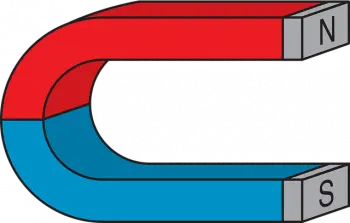
Magnetic energy is a form of energy that, despite its presence in a variety of modern technological applications, often goes unnoticed in our everyday lives.
In this article, we will explore what magnetic energy is, its origin in magnetic fields, the underlying physical foundations, and its various technological applications that have transformed our society.
What is magnetic energy?
Magnetic energy is a manifestation of energy that is intrinsically linked to magnetic fields.
These magnetic fields are areas in space where a magnetic force is exerted on moving objects or charged particles. They are generated from magnetic objects, such as magnets, and also by moving electrical currents.
Origin of magnetic energy
Magnetic energy has its origin in the property of magnetic objects to generate magnetic fields by aligning the magnetic moments of their atoms. In most cases, these objects have a magnetic north pole and a magnetic south pole. When two magnetic poles interact, they experience attractive or repulsive forces, proving the existence of magnetic energy.
Also, magnetic energy is generated when charged particles, such as moving electrons, create magnetic fields around them due to their motion.
Ampère's law describes how electric currents generate magnetic fields. This law establishes that the circulation of a magnetic field around a closed path is equal to the electric current that crosses the surface enclosed by the path.
Physical foundations of magnetic energy
Magnetic energy is governed by the following fundamental principles:
Magnetic intensity
The intensity of a magnetic field determines the force with which it acts on moving magnetic objects or charged particles. The stronger the field, the greater the magnetic force.
Lorentz's law of magnetic force describes the force experienced by a moving charged particle in a magnetic field.
Magnetic field direction
Magnetic fields have a specific direction, which is represented by magnetic field lines extending from the north pole to the south pole of the magnet, or in the direction of motion of the charged particles.
Lenz's law, which derives from Faraday's law, states that the direction of the induced current in a conductor is always such that it opposes the change in the magnetic field that is generating it.
Mechanical work
Magnetic energy can do mechanical work by moving magnetic objects or by applying forces to them. For example, two magnets can attract or repel each other, which involves doing mechanical work.
Technological applications of magnetic energy
Magnetic energy is essential in numerous technological applications. Here are some examples:
- Electric power generation : In power plants, generators use magnetic energy to convert it into electrical energy. This is accomplished by rotating a coil of wire in a magnetic field, thus inducing an electric current.
- Magnetic Levitation (Maglev) Trains : Maglev trains use magnetic fields to levitate and propel themselves over the tracks, reducing friction and allowing for surprisingly high speeds.
- Data Storage Technology: Hard drives and other magnetic storage devices use magnetic fields to encode and read information.
- Magnetic Resonance (MR) : MRI is a medical technique that uses magnetic fields to obtain detailed images of the interior of the human body, which facilitates the diagnosis of diseases.